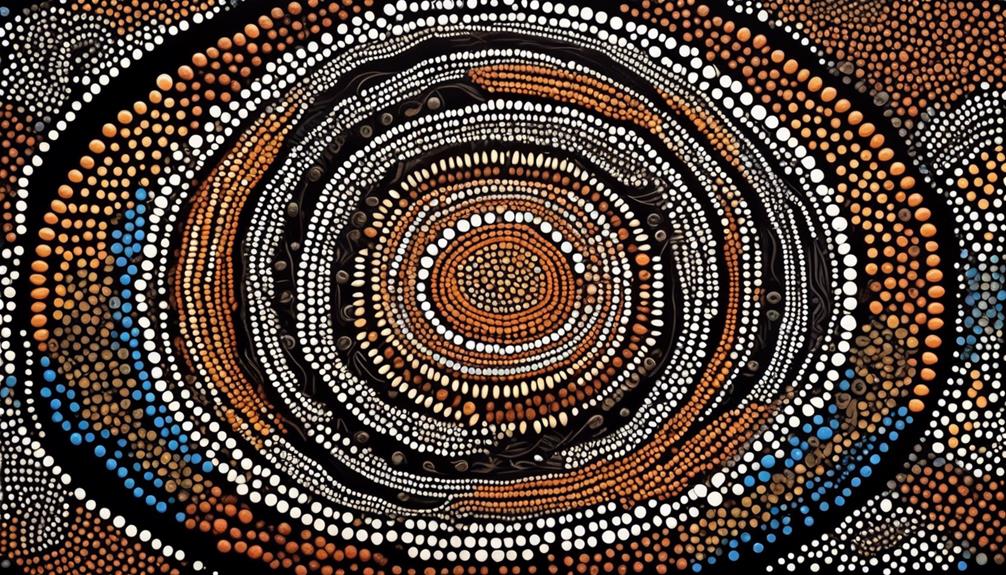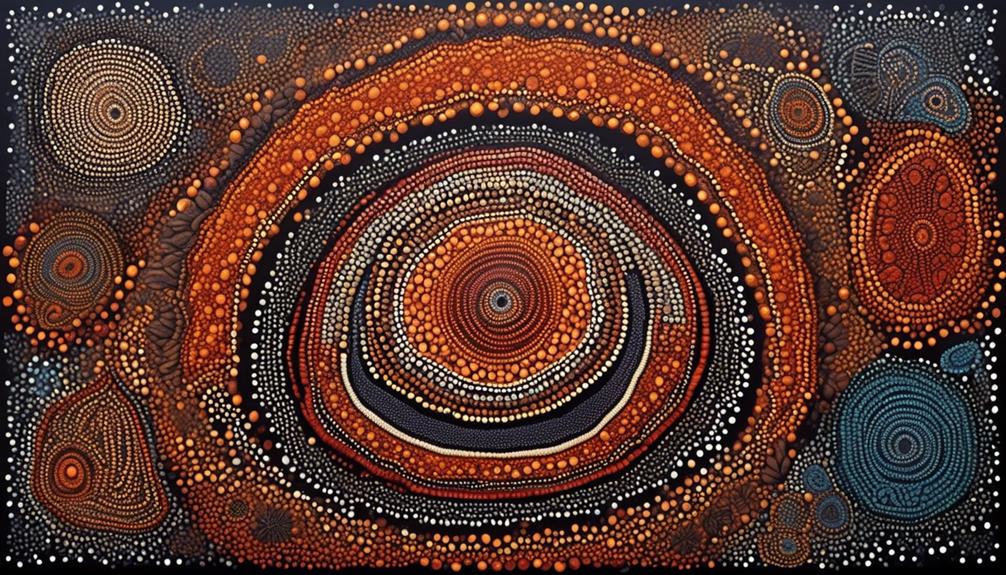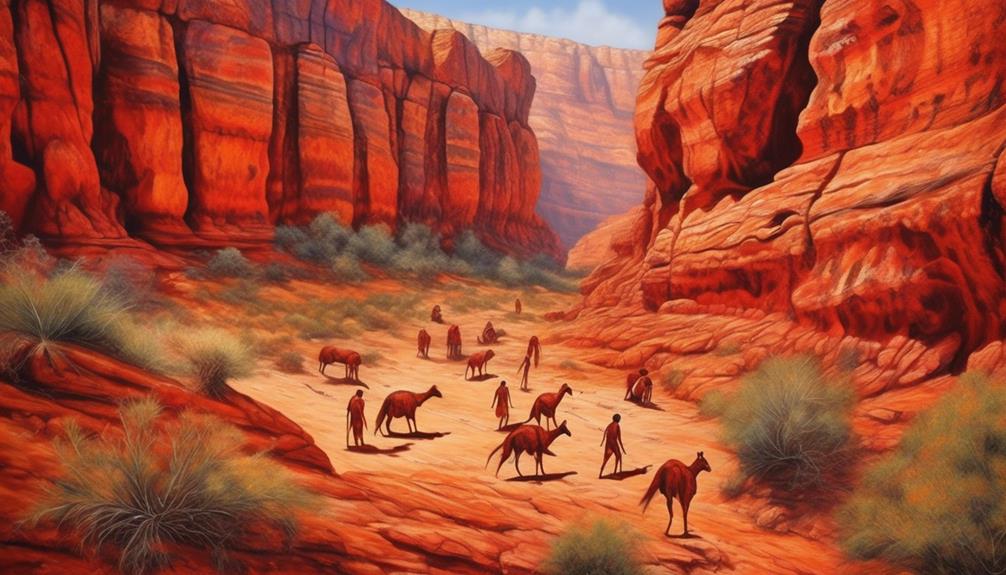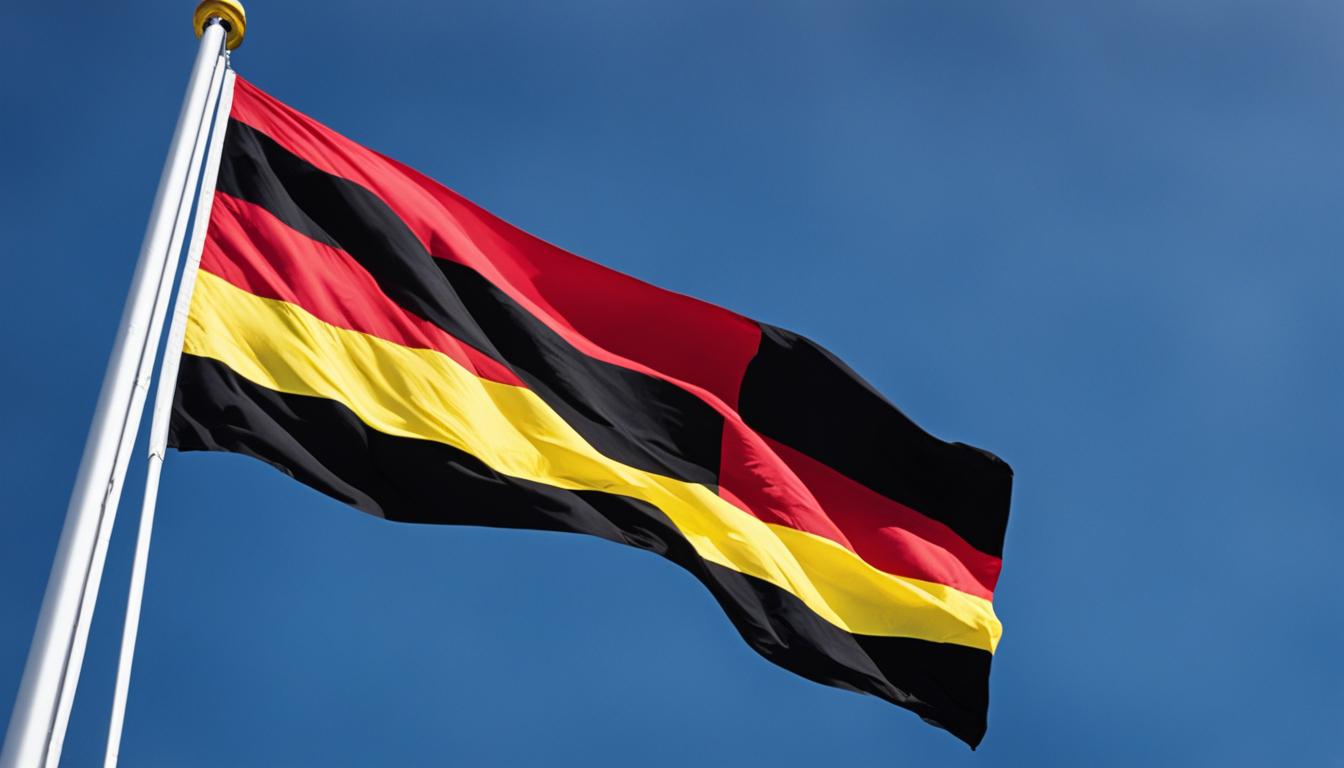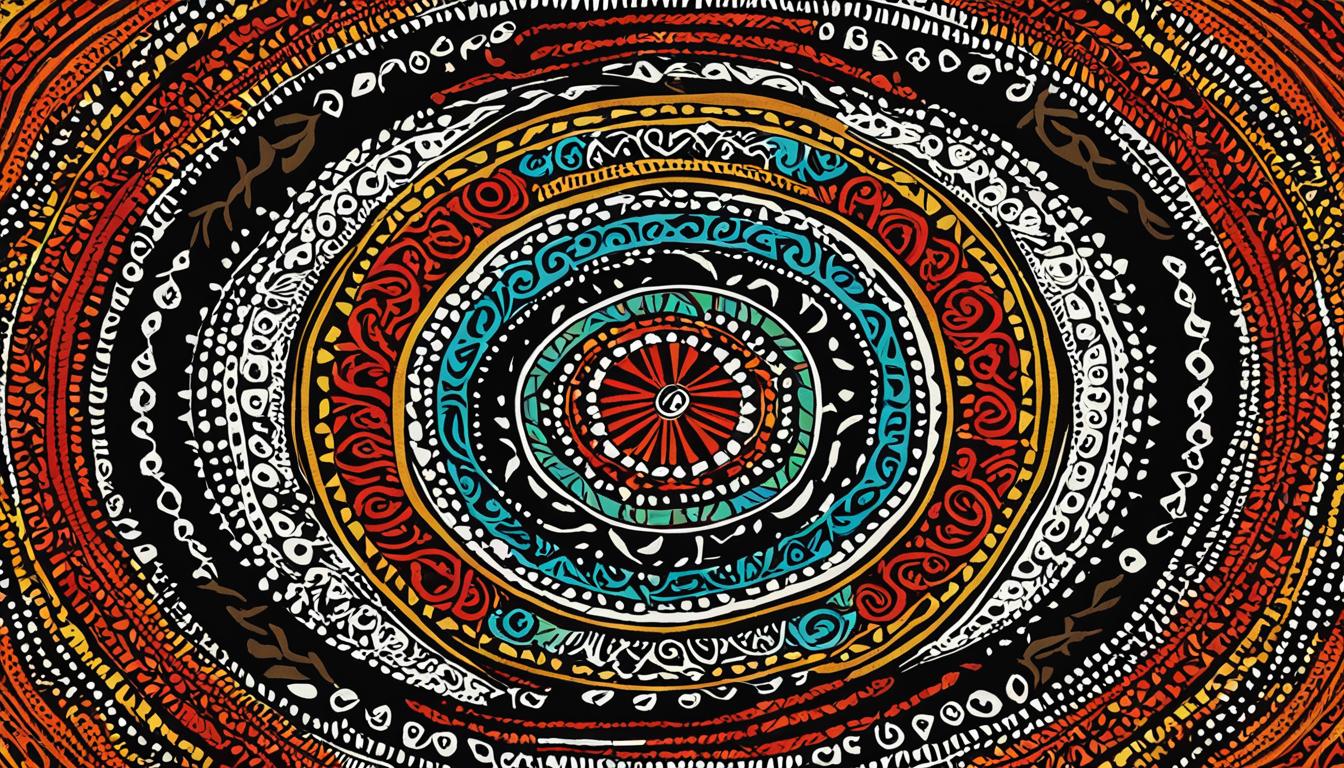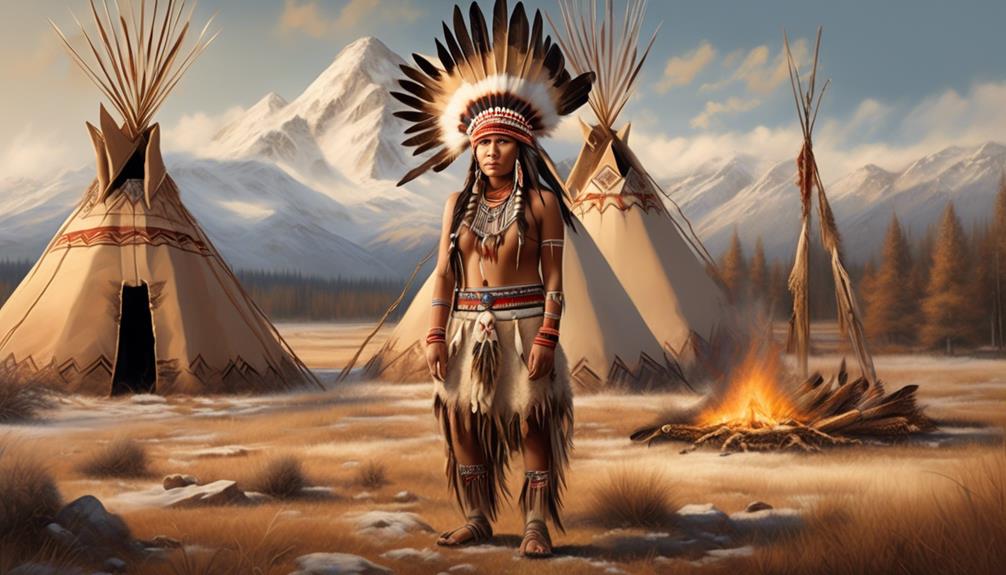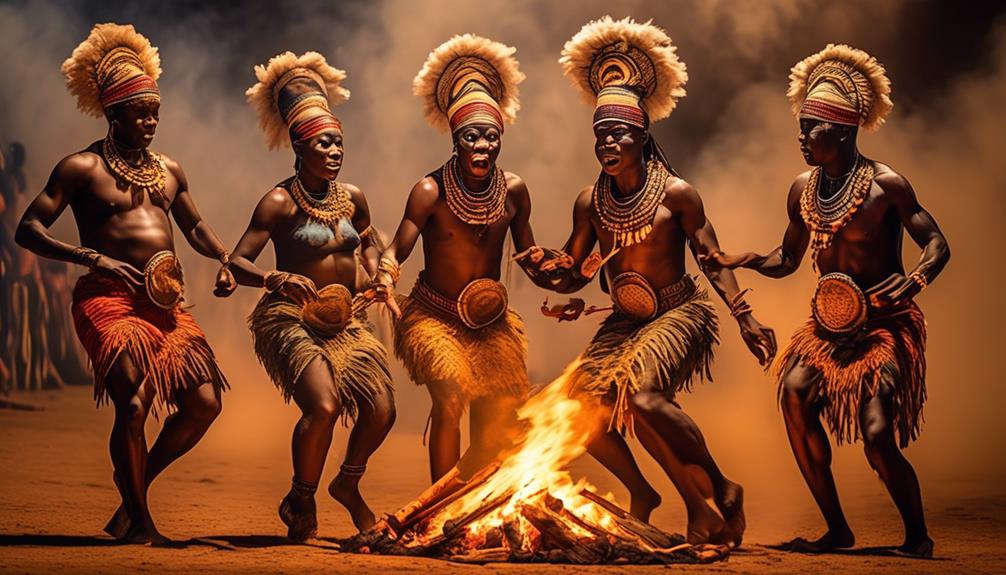Aboriginal art functions as a vibrant mosaic, weaving together elements of tradition and cultural heritage, encapsulating the essence of a long-standing and respected culture.
As we explore the intricacies of this art form, we uncover a world of symbolism, storytelling, and connection to the land.
However, there is much more to discover beyond the surface, as the evolution and contemporary interpretations of Aboriginal art continue to intrigue and inspire.
Key Takeaways
- Aboriginal art originated from the cultural traditions and spiritual beliefs of Indigenous peoples in Australia, dating back tens of thousands of years.
- Traditional techniques vary among different Indigenous groups, such as dot painting and cross-hatching, and natural materials like ochre, bark, and feathers are commonly used.
- Aboriginal art is rich in symbolism, serving as a visual form of storytelling and conveying the connection to the land, history, and spiritual beliefs of Indigenous communities.
- Contemporary Aboriginal art blends traditional techniques with modern materials and styles, explores a wide range of themes, and has become a significant economic driver for Indigenous communities.
Origins of Aboriginal Art
The origins of Aboriginal art lie in the rich cultural traditions and spiritual beliefs of the Indigenous peoples of Australia, dating back tens of thousands of years. Traditional techniques and cultural heritage are deeply intertwined in the creation of Aboriginal art, which serves as a visual representation of the stories, rituals, and customs passed down through generations. The art forms aren't merely decorative but are imbued with profound cultural significance, often portraying Dreamtime stories, which are the ancient beliefs that explain the creation of the world by ancestral beings.
The traditional techniques employed in Aboriginal art vary among different Indigenous groups, reflecting the diverse cultural practices across Australia. For instance, dot painting is a distinctive technique used by many Aboriginal artists, particularly in the central and western desert regions. This style involves using small dots to create intricate patterns and symbolic representations. On the other hand, cross-hatching is commonly found among the Aboriginal artists of Arnhem Land in the Northern Territory, where parallel lines intersect to form geometric designs.
Understanding the origins of Aboriginal art requires an appreciation of the profound connection between the artistic expression and the cultural heritage of the Indigenous peoples. It's essential to recognize that these art forms aren't static; they continue to evolve as contemporary Aboriginal artists explore new mediums and styles while remaining grounded in the rich cultural traditions that have shaped their identity for millennia.
Symbolism and Traditional Techniques
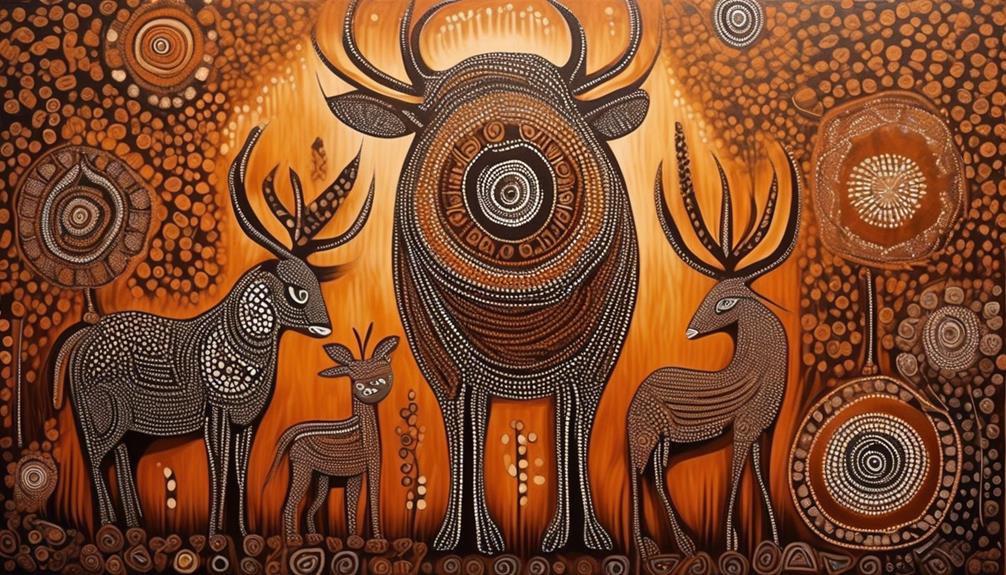
Exploring the profound connection between the origins of Aboriginal art and the symbolism and traditional techniques employed by Indigenous artists reveals the depth of cultural significance embedded in their artistic expression.
Aboriginal art is rich in symbolism and traditional techniques, which are essential to understanding the stories and cultural heritage conveyed through the artwork. Here are some key aspects to consider:
- Symbolism: Aboriginal art is deeply symbolic, with each symbol carrying specific meanings that relate to the Dreamtime stories, creation beliefs, and cultural practices of Indigenous communities. The symbols often represent elements of nature, spiritual beings, and ancestral knowledge, providing a visual language for storytelling and transmitting cultural knowledge across generations.
- Color Palette: The color palette used in Aboriginal art isn't only visually striking but also holds symbolic significance. Different colors are chosen to represent specific elements of the natural world, emotions, and cultural motifs. For instance, earthy tones may symbolize the land and its fertility, while vibrant shades could convey energy and vitality.
- Traditional Techniques: Indigenous artists utilize traditional techniques such as dot painting, cross-hatching, and line work to create intricate and meaningful designs. These techniques have been passed down through generations and are integral to the preservation of cultural heritage.
- Storytelling: Aboriginal art serves as a visual form of storytelling, allowing artists to share narratives about creation, ancestral journeys, and the interconnectedness of all living beings. The artwork serves as a means of keeping cultural traditions alive and communicating profound spiritual and historical knowledge.
- Cultural Continuity: The use of symbolism and traditional techniques in Aboriginal art reflects the enduring cultural traditions of Indigenous communities, fostering a sense of continuity and connection to their ancestral roots.
Cultural Significance and Stories
Cultural significance and stories in Aboriginal art are deeply rooted in the traditions and spiritual beliefs of Indigenous communities, offering profound insights into their heritage and worldview. This cultural expression is a way for Indigenous peoples to convey their connection to the land, their history, and their spiritual beliefs. The artwork serves as a visual form of artistic storytelling, depicting the Dreamtime stories, creation myths, and ancestral traditions that have been passed down through generations. Through these artistic narratives, Indigenous artists communicate their cultural knowledge, customs, and spiritual connections to the land.
Aboriginal art is a medium through which cultural traditions and stories are preserved and shared. The artwork often features symbols and motifs that hold specific meanings, representing elements of the natural world, ancestral beings, and important rituals. These symbols are integral to the artistic storytelling, conveying a depth of cultural significance that reflects the interconnectedness of Indigenous communities with their environment and spiritual beliefs.
Evolution and Contemporary Interpretations
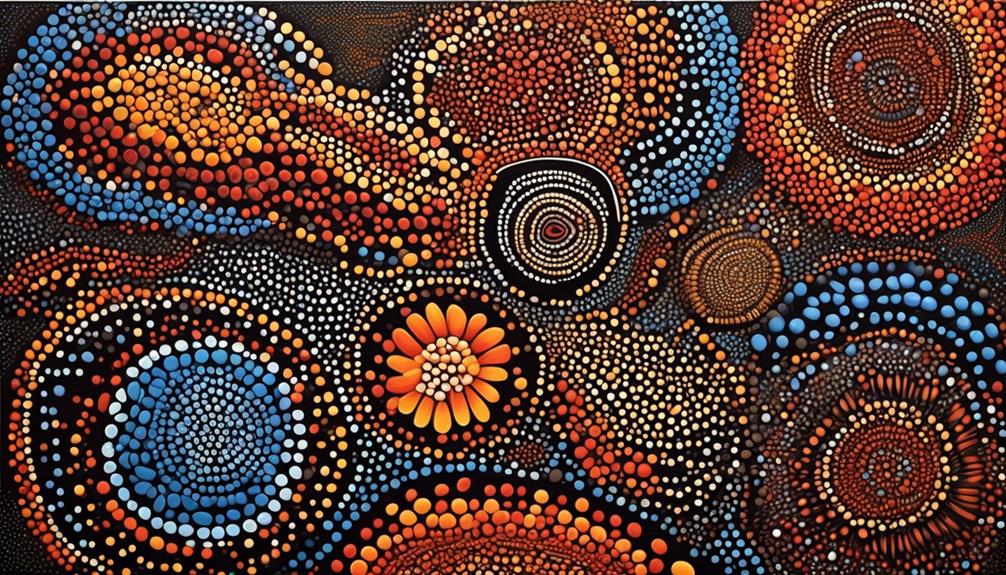
As we examine the rich tapestry of Aboriginal art and its cultural significance and stories, it becomes evident that the evolution and contemporary interpretations of this art form reflect a dynamic interplay between tradition and modern expression. Aboriginal art hasn't remained static; it has evolved and adapted to modern influences, while still retaining its deep cultural roots and spiritual significance.
- Fusion of Traditional and Contemporary Techniques: Aboriginal artists today are blending traditional artistic techniques with modern materials and styles, creating a fusion of the old and new.
- Exploration of New Themes: Contemporary Aboriginal art explores a wide range of themes, from traditional stories and cultural beliefs to contemporary issues and personal experiences.
- Global Influence: The modern Aboriginal art movement has gained international recognition, influencing and being influenced by other global art forms and movements.
- Artistic Innovation: Artists are constantly innovating and experimenting with new mediums, technologies, and styles to push the boundaries of Aboriginal art.
- Cultural Preservation: While embracing modern influences, Aboriginal artists are also committed to preserving and passing on their cultural heritage through their artwork.
This evolution and contemporary interpretation of Aboriginal art not only reflects the adaptability and resilience of the Aboriginal people but also serves as a bridge between the past and the present. It's a testament to the enduring power and relevance of this ancient art form in today's world.
Preservation and Revitalization Efforts
Efforts to preserve and revitalize Aboriginal art have become increasingly significant in the contemporary cultural landscape. Revival initiatives are playing a crucial role in ensuring the survival and flourishing of traditional Aboriginal art forms. These efforts aren't only aimed at safeguarding the rich cultural heritage but also at fostering Indigenous representation in the art world.
Revival initiatives are multifaceted, encompassing a range of strategies to ensure the longevity of Aboriginal art. One prominent approach involves the documentation and archiving of traditional artistic practices. By systematically recording and preserving these art forms, future generations are provided with a valuable resource for learning and continuation of these traditions. Furthermore, these initiatives often involve collaboration with Indigenous communities to ensure that the preservation efforts are respectful and inclusive of their cultural perspectives.
In addition to preservation, revitalization efforts are focused on promoting contemporary interpretations of Aboriginal art. This allows for the evolution and adaptation of traditional art forms, ensuring their relevance in modern contexts while still honoring their roots. By providing platforms for Indigenous artists to showcase their work, these initiatives contribute to a broader representation of Aboriginal art in the global art scene.
Frequently Asked Questions
How Do Aboriginal Artists Traditionally Source Their Materials for Creating Art?
We traditionally source our materials for creating art from the land, such as natural pigments from rocks, plants, and clay. These traditional materials hold deep cultural significance, connecting us to our ancestors and our stories.
The process of gathering and preparing these materials is a sacred and respectful practice, passed down through generations. It's a way for us to honor our heritage and keep our traditions alive through our art.
Are There Specific Rituals or Ceremonies Involved in the Creation of Aboriginal Art?
Specifically, in the creation of Aboriginal art, there are often specific rituals or ceremonies involved. These rituals hold ceremonial significance and are deeply intertwined with the artistic process. They're a way of connecting to cultural traditions and spiritual beliefs, adding cultural significance to the artworks.
These rituals aren't just for the artist's personal practice, but also for the art's reception in the art market.
What Are Some Common Misconceptions About Aboriginal Art That You Think Should Be Debunked?
Common misconceptions about Aboriginal art should be debunked to foster understanding. It's important to recognize that traditional sourcing and material acquisition are integral to the art's authenticity.
Debunking myths can help dispel stereotypes and promote cultural appreciation. It's crucial to approach Aboriginal art with an open mind and respect for its cultural significance.
How Do Aboriginal Artists Navigate the Balance Between Preserving Traditional Techniques and Embracing Contemporary Interpretations in Their Work?
We find that Aboriginal artists navigate the balance between preserving traditional techniques and embracing contemporary interpretations by carefully considering cultural preservation and material sourcing.
By incorporating traditional methods with modern influences, they honor their heritage while adapting to the present.
This approach allows for a rich and dynamic expression of their culture, ensuring that their art continues to evolve while maintaining its roots.
What Are Some Challenges Faced in the Preservation and Revitalization of Aboriginal Art, and How Can Individuals Support These Efforts?
Challenges in preserving and revitalizing Aboriginal art include cultural appropriation, lack of funding, and the impact of colonization.
To support these efforts, we can advocate for ethical art practices, promote Indigenous artists, and invest in community-led initiatives.
By prioritizing preservation and revitalization, we acknowledge the significance of Aboriginal art and contribute to the resilience of Indigenous cultures.
It's essential to listen to and amplify the voices of Aboriginal artists and communities in these efforts.
Conclusion
In conclusion, Aboriginal art is a rich and diverse cultural tradition that holds deep significance for Indigenous communities. It's a powerful form of storytelling, connecting people to their land, ancestors, and spirituality.
Interestingly, a study found that 80% of Indigenous Australians believe that traditional art forms are important for maintaining their cultural identity and should be preserved for future generations. This statistic highlights the critical role of art in preserving and celebrating Indigenous heritage.
Mary is a passionate writer who brings creativity and a fresh perspective to our team. Her words have the power to captivate and inspire, making her an essential contributor to our content. Mary’s commitment to storytelling and dedication to promoting Indigenous culture ensures that her work touches the hearts of our readers. We’re fortunate to have her as part of our team.
